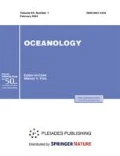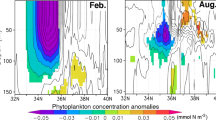Abstract
The transition from winter vertical mixing to the formation of the spring thermocline in the southeastern Baltic Sea is studied based on data from the hydrophysical measurements program (11 expeditions) in the Russian part of Gdansk Bay in March–June 2010, 2011, and 2013. CTD measurements were taken along the standard 18-km transect across the isobaths with a 500-m step abeam the city of Baltiysk. A set of frequently measured data was collected in a 1–2 week interval from the end of March to the beginning of May, which made it possible to analyze the transformation of the vertical thermal structure of water from inverse winter type to the summer stratification with the transition of temperature over the temperature of the density maximum. Series of repeated measurements at the deep and coastal stations as well as surface and subsurface towed measurements were carried out. The fact that lenses of freshened warmer water appear at the surface almost simultaneously with intensification of cold intrusions in intermediate (10–40 m) layers makes it possible not only to confirm the advective nature of the formation of the spring thermocline in the Baltic Sea, but also to hypothesize about the intensification of intrabasin exchange when winter-time vertical mixing ceases: the potential energy excess supported by vertical mixing in the 60-m upper quasi-homogeneous layer (UQL) of the Baltic Proper, in which the horizontal estuarine salinity gradient is significant, is converted to kinetic energy of exchange currents as the mixing process terminates. Such water dynamics makes it possible to explain the intensification of intrusions in the Baltic in spring and the formation of the cold intermediate layer due to the fast propagation of late-winter UQL water from the Bornholm Basin to the Baltic Proper. The results agree well with earlier published studies of other authors.
Similar content being viewed by others
References
A. V. Bagaev and I. P. Chubarenko, “Thermohaline structure of waters above the brackish sea shelf during the early spring warm period,” Proceedings of the XIV International Scientific-Technical Conference “Modern Methods and Tools for Oceanological Studies” (Shirshov Institute of Oceanology, Russian Academy of Sciences, Moscow, 2015), Vol. 1, pp. 65–67.
V. M. Zhurbas and V. T. Paka, “Intrusive stratification of halocline in the Gotland basin caused by a large flood of North Sea waters into the Baltic Sea in January 1993,” Okeanologiya (Moscow) 37, 549–557 (1997).
N. B. Stepanova, I. P. Chubarenko, and S. A. Shchuka, “Structure and evolution of the cold intermediate layer in the southeastern part of the Baltic Sea by the field measurement data of 2004–2008,” Oceanology (Engl. Transl.) 55, 25–35 (2015).
A. I. Tikhomirov, Thermal Status of the Large Lakes (Nauka, Leningrad, 1982) [in Russian].
I. P. Chubarenko, “Horizontal convective water exchange above a sloping bottom: The mechanism of its formation and an analysis of its development,” Oceanology (Engl. Transl.) 50, 166–174 (2010).
I. P. Chubarenko, Horizontal Convection above Submerged Slopes (Terra Baltika, Kaliningrad, 2010) [in Russian].
N. Demchenko, I. Chubarenko, and S. Kaitala, “The development of seasonal structural fronts in the Baltic Sea after winters of varying severity,” Clim. Res. 48, 73–84 (2011).
K. Eilola, “Development of a spring thermocline at temperatures below the temperature of maximum density with application to the Baltic Sea,” J. Geophys. Res.: Oceans 102 (4), 8657–8662 (1997).
F. Janssen, C. Schrum, and J. O. Backhaus, “A climatological data set of temperature and salinity for the Baltic Sea and the North Sea,” Dtsch. Hydrogaph. Z., No. 9, (1999).
G. Kullenberg, “Observations of the mixing in the Baltic thermo- and halocline layers,” Tellus 29, 572–587 (1977).
N. Kuzmina, V. Zhurbas, B. Rudels, and T. Stipa, “The structure and driving mechanisms of the Baltic intrusions,” J. Phys. Oceanogr. 35 (6), 1120–1137 (2005).
M. Leppäranta and K. Myrberg, Physical Oceanography of the Baltic Sea (Springer-Verlag, Chichester, 2008).
J. Malm, “Spring circulation associated with the thermal bar in large temperate lakes,” Nord. Hydrol. 26, 331–358 (1995).
“MEDOC Group Observation of formation of deep water in the Mediterranean Sea, 1969,” Nature 227, 1037–1040 (1970).
T. Stipa and J. Vepsäläinen, “The fragile climatological niche of the Baltic Sea,” Boreal Environ. Res. 7, 335–342 (2002).
Author information
Authors and Affiliations
Corresponding author
Additional information
Original Russian Text © I.P. Chubarenko, N.Yu. Demchenko, E.E. Esiukova, O.I. Lobchuk, K.V. Karmanov, V.A. Pilipchuk, I.A. Isachenko, A.F. Kuleshov, V.Ya. Chugaevich, N.B. Stepanova, V.A. Krechik, A.V. Bagaev, 2017, published in Okeanologiya, 2017, Vol. 57, No. 5, pp. 702–709.
† Deceased.
Rights and permissions
About this article
Cite this article
Chubarenko, I.P., Demchenko, N.Y., Esiukova, E.E. et al. Spring thermocline formation in the coastal zone of the southeastern Baltic Sea based on field data in 2010–2013. Oceanology 57, 632–638 (2017). https://doi.org/10.1134/S000143701705006X
Received:
Accepted:
Published:
Issue Date:
DOI: https://doi.org/10.1134/S000143701705006X




